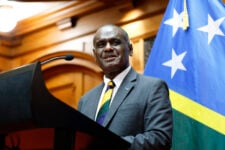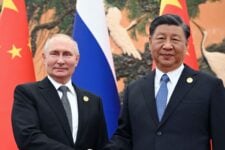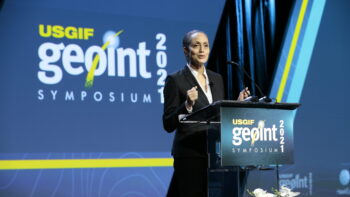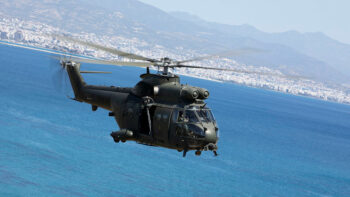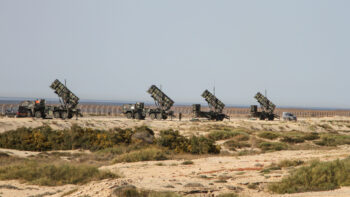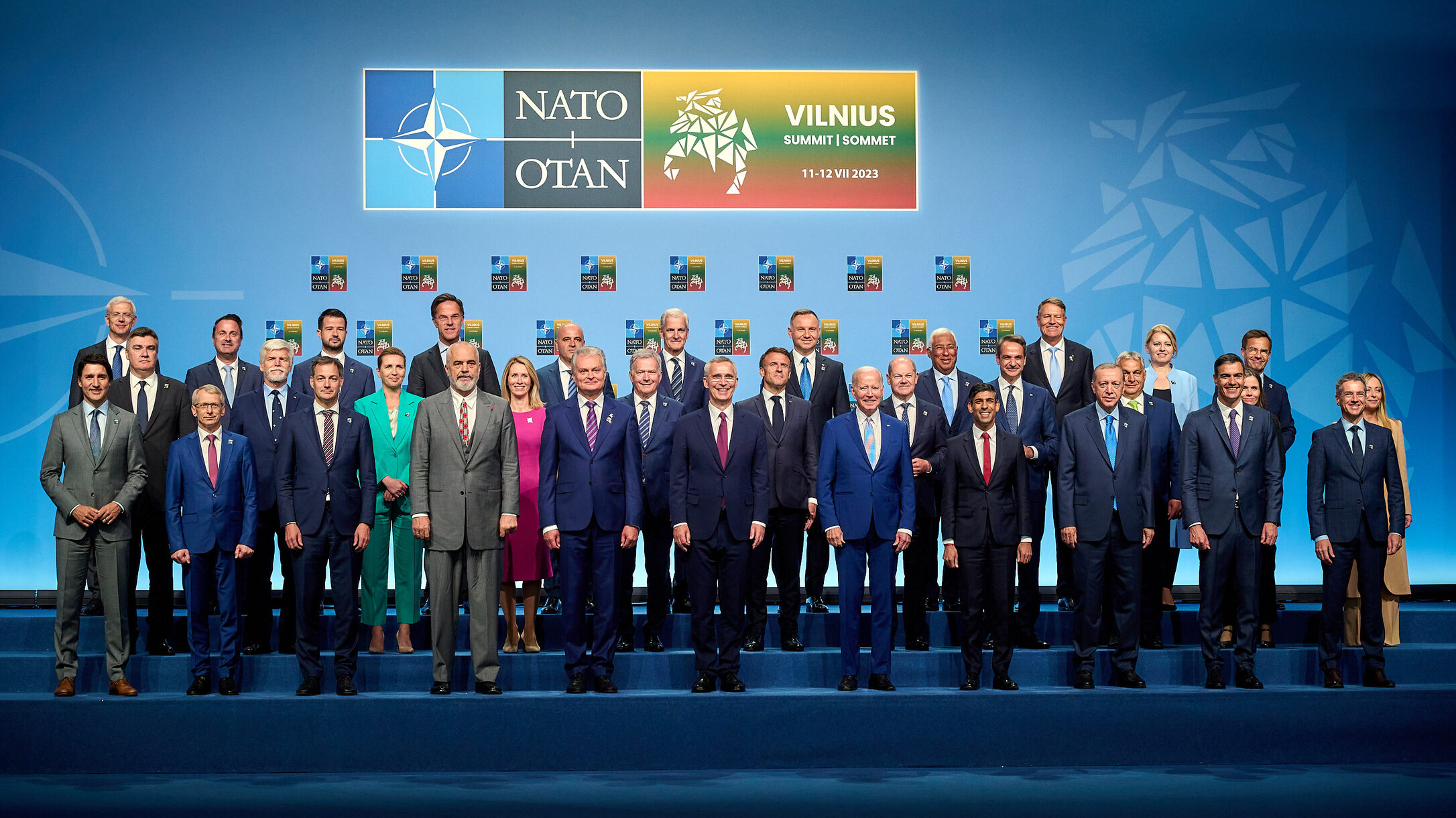
The official portrait of NATO leaders at the 2023 Vilnius Summit. (NATO)
With the Vilnius Summit concluded, NATO observers can take a breath — and take a step back to see what was really accomplished at the meeting, which brought the leaders of the member nations together to plot out the future of the alliance. In this new op-ed, NATO scholar John Deni argues that despite some modest movements, the Summit failed to deliver a historic moment for the alliance.
Not every NATO summit can be a historical landmark. Some are naturally more important than others — London in 1990, Madrid in 1997, or Wales in 2014 stand out in particular. Nonetheless, the Vilnius meeting, billed as potentially a historic event, ended with the alliance essentially marking time.
Vilnius in 2023 will be remembered most likely for Turkish President Recep Tayyip Erdogan’s decision to greenlight Sweden’s membership application, but this decision occurred the day before the summit even began and seemed increasingly likely in any case following recent Turkish elections. Otherwise, there was little significant movement on several key issues, leaving much on the table for the alliance’s 75th birthday summit next year in Washington, DC.
The summit communique read like it hadn’t received a thorough edit by a single editor, or if it did, in great haste. This probably reflects the last-minute nature of haggling over the Ukraine language. Despite the drama surrounding Ukraine’s candidacy — energized by Ukrainian President Volodymyr Zelenskyy’s vocal frustration over NATO’s shifting approach to his country’s membership — there was little substantive change in Ukraine’s relationship with NATO and certainly no clearer timeline for membership than what was offered at the Bucharest summit in 2008.
Alliance leaders employed a kind of tautological phrasing — “We will… extend an invitation to Ukraine… when Allies agree” — to paper over what are evidently wide differences of opinion on this issue. NATO leadership did agree to turn the NATO Ukraine Commission into a “Council,” which will reportedly provide Kyiv with a stronger voice inside the alliance, but this rather esoteric change means little outside NATO’s Brussels headquarters. Allies also decided to do away with the requirement for Kyiv to fulfill a Membership Action Plan, yet they simultaneously retained undefined “conditions” necessary before Ukraine can join.
The excessive attention paid to the language on Ukrainian membership also obscured that Ukraine failed to come away with game changing security assistance. Certainly, Kyiv received new promises, which will help the war effort. Germany announced it would provide $770 million in additional assistance, including 25 more Leopard tanks, 40 additional infantry fighting vehicles, and two more Patriot air defense missile launchers. France announced it would send 150-mile range “Scalp” cruise missiles, similar to the Storm Shadow missiles sent by the United Kingdom. Norway announced an additional $240 million for unspecified equipment and other support. And the Netherlands and Denmark announced they had signed up nine other countries to participate in an F-16 training consortium for Ukrainian pilots to be run out of Romania and which could start operations as soon as next month.
RELATED: At NATO summit, Zelenskyy disappointed but finds solace in G7 pledge, seeks long-range US weapons
But for that to be the main haul out of the NATO summit simply wasn’t enough. Most allies, and especially those that can produce the heavy equipment and ammunition necessary for Ukraine’s current counteroffensive, have yet to place their defense industries on a wartime footing. Germany in particular has yet to formulate sufficient long-term contracts that will incentivize industry to add additional productive capacity, and French officials may be reluctant to take on the fiscal costs associated with turning Ukraine’s military advantage into a kind of Eastern European version of Israel.
The additional assistance and ways to bridge the gap between what Kyiv has and what it needs should have been the primary focus of discussion by the allies and their main message regarding Ukraine. Instead, it was occluded by the drama over whether Ukraine was going to be given a path into the alliance, despite clear signposts from Washington that such a move wasn’t going to happen this week.
And Ukraine wasn’t the only place where the Summit delivered less than hoped.
For instance, the alliance made no significant headway on its commitment to deterrence by denial in Eastern Europe. The alliance’s signature initiative there — the enhanced Forward Presence (eFP) — remains too small and reliant on reinforcement after a crisis has already begun. Immediately before the start of the summit, Canadian Prime Minister Justin Trudeau announced a doubling of the Canadian eFP contingent in Latvia, to as many as 2,200 troops. But this additional force structure won’t be complete until 2026 at the earliest and it will remain undersized relative to what many experts think is necessary in the East and especially in the Baltic states.
Meanwhile, there was no significant change to the defense investment pledge (DIP), a commitment made by alliance leaders at their 2014 summit in Wales more commonly known as the 2 percent goal. The allies claimed in Vilnius that they agreed to treat the 2 percent spending level as a floor, instead of merely a goal. However, a careful reading of the Wales summit language indicates the allies were already treating 2 percent as a floor: “Allies currently meeting the NATO guideline to spend a minimum of 2% of their Gross Domestic Product (GDP) on defence will aim to continue to do so…” In other words, despite how it was presented in the lead up to the conference, no real change was made.
Finally, allied leaders in Vilnius did approve new operational plans for the defense of Europe. These plans play a critical role in the credibility of the alliance’s mutual defense clause as well as in shaping the force levels and the capabilities the allies will develop over the coming years to enable that defense. However, their endorsement by heads of state and government was largely a pro forma matter following their completion this past spring and endorsement by allied ministers/secretaries of defense in June.
Certainly, it is a weighty, important thing for the leaders of 31 allies to gather and discuss their most important duty – to protect and defend their citizens. Nonetheless, on several fronts the achievements of the Vilnius summit leave much on the table for the allies to continue discussing and refining, hopefully in time for the next summit, in Washington next summer.
John R. Deni is a research professor at the US Army War College’s Strategic Studies Institute, a nonresident senior fellow at the Atlantic Council, and an associate fellow at the NATO Defence College. He’s the author of NATO and Article 5. The views expressed are his own.


